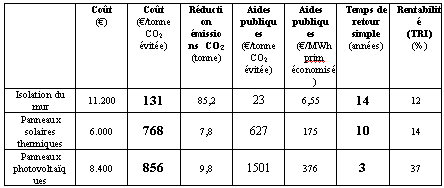Analyzes about subsidy and subsidy policies regarding Solar Photovoltaic. Article written by an energy official of the Walloon Region.
This article is about the plan SolWatt from the Walloon Region but the reasoning is applicable to all subsidies, only the figures differ slightly.
Environmental efficiency or financial profitability? A dilemma resulting from inconsistent public aid. Should I maximize energy savings or my financial profitability?
This is the question many of you will ask yourself after reading this article. You might even ask yourself why we are faced with this situation.
The best econological choice: solar thermal, solar photovoltaic or insulation?
Let us start from an example to illustrate our point. Or Mr. Dupond, who has a sum of money that he is ready to invest in energy savings. He believes that several actions are possible in his home, of which he is the proud owner, and he chooses three:
1) Insulating a blind gable from the outside (a blind pinion as we meet very often). The wall is 80m2 and 32cm thick of brick. In addition, its roof is very well insulated, its frames and glazing among the most efficient, and it has an HR natural gas boiler.
2) The installation of a thermal solar panel system for the preparation of its domestic hot water.
3) The installation of photovoltaic solar panels.
Mr. Jones has received quotes and calculations to determine which of the measures is the most interesting. It ends in the following table.

Hypotheses of the calculation: Lifespan of investments: wall insulation 40 years, thermal panels 20 years, photovoltaic panels 20 years. Gas heating, boiler efficiency 90%, 7c € / kWh useful and annual increase in the price of gas by 6%. Electricity price: 19 c € / kWh and annual increase of 4%. PV installation: 1200Wc for 8400 €, zero maintenance costs. Solar thermal installation: 4m² for 6000 €, useful annual production of 350kWh / m2, zero maintenance costs. External insulation: cost 140 € / m², 8cm EPS + plaster. Sale of CVs: € 92 / CV. CO2 emissions: 456kgCO2 / MWh of electricity, 251kgCO2 / MWh natural gas. Discount rate 4%. House located in Brabant Wallon in Belgium.
More: download the chart of caculs
What do you think Mr. Dupond will do?
He will naturally install photovoltaic solar panels and congratulate himself on the profitability of his investment, even if it is the least effective measure to achieve energy savings. The operation will cost the community 1501 euros per tonne of CO2 avoided and will save only 9,8 tonnes of CO2 over 20 years.
When reading the table, we see that 1 € invested in the insulation of the wall is 6 times more efficient from an energy point of view than if it is invested in the installation of thermal or photovoltaic solar panels.
However, the insulation of the wall is frankly less interesting from a financial point of view than the acquisition of photovoltaic solar panels when the public aid is integrated.
This contradiction stems from the fact that disproportionate public aid is granted to the least effective measures. It is ironic that the most effective measure is ultimately the least financially attractive.
Ultimately, the whole of society loses out. How did we get there, when we know that we have little time and resources left to try to create a society offering a satisfactory quality of life despite the scarcity of energy? All our resources and all our energy should be focused on priority measures, the sooner the better.
As you will have understood, we hope that you will not follow the example of Mr. Dupond who is only seeking to maximize his profit at the expense of the community. On the contrary, we hope that you will take your responsibilities by opting for the investment which maximizes energy savings, thus rejecting the temptation to make a juicy investment (financed by the community) with very little environmental gain.
Econological conclusion and full of common sense
Should not each technique be supported in proportion to the emission savings it allows?
More: download the solar profitability calculation method and adapt it to your case
Debate on forums: solwatt profitable in 7 years?, photovoltaic profitability or even unprotected PV solar panels?

